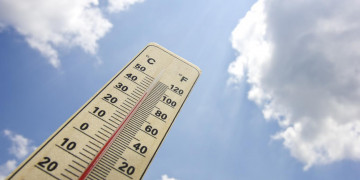You’re not imagining it: Heat waves are becoming more severe, putting the safety and well-being of workers at risk. Addressing heat safety has become an essential part of EHS practices around the world.
In this post, we'll explore the impact of climate change on EHS heat safety practices, review the signs and symptoms of heat illness, and offer ways to mitigate the risks associated with heat waves.
Understanding the Escalating Impact of Heat Waves on EHS
The 2023 summer has shown a concerning surge in emergency room visits and fatalities due to heat. With some of these taking place on the job, it is crucial for EHS professionals to take proactive steps to safeguard their workforces in times of extreme heat. This is especially true for countries where governments have yet to establish regulations that set maximum safe heat limits for workers. The United States does not have national standards in place, and only five states- California, Colorado, Minnesota, Oregon and Washington have enacted heat-related illness prevention requirements. California and Washington’s regulations cover only outdoor workers, Minnesota’s covers only indoor workers, Oregon’s covers both indoor and outdoor workers, and Colorado’s covers only agricultural workers.
Learn more about all the EHS concerns summer weather brings in our post Bring on the Heat: Get Ahead of Summer EHS Hazards
Are heat waves really occurring more frequently?
Heat waves are indeed occurring more frequently, and there are several reasons for this trend.
Source: epa.gov
Climate change is a significant factor driving the increased frequency of heat waves. Rising global temperatures result in more intense and prolonged periods of extreme heat. Urbanization and the heat island effect exacerbate heat wave conditions in cities, as concrete and asphalt retain heat and limit cooling.
The Role of EHS Professionals in Heat Wave Safety
Heat illness can have serious consequences, ranging from mild discomfort to life-threatening conditions like heat stroke. As an EHS professional, you play a significant role in ensuring your organization has the correct heat wave safety protocols in place to avoid heat illness incidents.
The rise in heat-related illnesses and fatalities is a global issue. In Texas, where heat waves have become more frequent and intense, there has been a noticeable rise in heat-related illnesses and deaths. Similarly, India has also encountered severe heat waves that put a strain on healthcare systems and highlighted the importance of preventive measures.
Implementing a heat wave safety program within your organization requires both recognizing and preventing heat illness.
Recognizing Types of Heat Illness
Heat illness refers to a range of conditions that occur when the body's core temperature rises to dangerous levels due to exposure to high temperatures and excessive heat. These conditions can range from mild to life-threatening and are often associated with working in hot environments or engaging in strenuous physical activities in the heat.
There are four main types of heat illness your workforce should be trained to recognize in themselves and others.
Heat rash
Heat rash occurs when sweat is trapped in the skin's pores, leading to skin irritation. It is the most common heat-related problem in hot work environments.
Symptoms:
- Clusters of red bumps on the skin.
- Often appears on the neck, upper chest, and folds of the skin.
First Aid:
- Work in a cooler, less humid environment when possible.
- Keep the affected area dry.
Heat cramps
Heat cramps are caused by the loss of body salts and fluids through sweating, resulting in low salt levels in muscles and painful cramps. These usually affect tired muscles, especially those used for performing the work.
Symptoms:
- Muscle spasms and pain.
First Aid:
- Have the worker rest in a shady and cool area.
- Provide the worker with water or other cool beverages.
- Wait for a few hours before allowing the worker to return to strenuous work.
- Seek medical attention if cramps persist.
Heat exhaustion
Heat exhaustion occurs when the body loses water and salt through heavy sweating, leading to an imbalance in the body's electrolytes and fluid levels.
Symptoms:
- Cool, moist skin.
- Heavy sweating.
- Headache, nausea, and vomiting.
- Dizziness and lightheadedness.
- Weakness and irritability.
- Fast heartbeat and excessive thirst.
First Aid:
- Have the worker sit or lie down in a cool, shady area.
- Provide plenty of water or other cool beverages to drink.
- Apply cold compresses or use ice packs.
- Seek immediate medical attention if symptoms worsen or do not improve within 60 minutes.
- Do not allow the worker to return to work that day.
Heat stroke
Heat stroke is the most severe and life-threatening heat-related illness. It occurs when the body's temperature regulation fails, and the body becomes unable to cool itself down through sweating.
Symptoms:
- Confusion and irrational behavior.
- Loss of consciousness and seizures.
- Lack of sweating (usually).
- Red, hot, and dry skin.
- Very high body temperature (typically above 41°C or 106°F).
First Aid:
- Call 911 immediately for emergency medical assistance.
- Move the worker to a shady and cool area.
- Loosen their clothing and remove outer layers.
- Cool the worker with fans, cold packs, or wet towels.
- Offer fluids (preferably water) as soon as possible.
- Stay with the worker until help arrives.
Heat stroke is a medical emergency that requires immediate attention, as it can lead to severe complications and even death if not treated promptly.
Preventative Measures for Heat Wave Safety
Prevention is the best way to ensure your workers remain safe during a heat wave. The following measures should be part of your overall heat safety plan and fulfill OSHA's recommendations to employers.
Develop heat illness prevention policy: Establish a clear and comprehensive policy that outlines heat safety protocols and guidelines. This policy should include recommendations on staying hydrated, taking breaks in cooler areas, and recognizing early signs of heat-related illnesses. Each site should have a designated person with the appropriate training to activate the employer's heat illness prevention program.
Provide training and education: Conduct regular heat safety training sessions for employees, supervisors, and managers. Educate them on the risks of heat-related illnesses, how to identify symptoms, and the appropriate actions to take in case of emergencies.
Conduct heat stress assessments: Regularly assess the workplace for potential heat stress hazards. Measure temperature, humidity, and radiant heat in different areas to identify hotspots where workers may be at higher risk.
Implement engineering controls: Install ventilation systems, reflective surfaces, and cooling fans to reduce heat buildup in work areas. Providing shaded rest areas and proper ventilation can significantly lower the risk of heat-related illnesses.
Monitor weather and heat index: Keep a close eye on weather forecasts and heat index levels. Implement an early warning system to alert workers and supervisors when extreme heat events are anticipated, allowing for timely adjustments to work schedules or temporary suspension of outdoor work.
Encourage acclimatization: Encourage workers to gradually adapt to working in hot conditions, especially at the beginning of the hot season. Avoid assigning heavy or physically demanding tasks during peak heat hours. For new employees working in high temperatures, give them an acclimiation period of two weeks.
Promote hydration: Ensure workers have easy access to cool, potable water at all times. Encourage frequent water breaks to prevent dehydration and heat stress.
Offer personal protective equipment (PPE): Provide lightweight, breathable, and heat-resistant clothing that helps reduce heat stress while offering adequate protection for specific work tasks.
Establish an emergency response plan: Develop a clear and effective heat emergency response plan that includes procedures for recognizing and responding to heat-related emergencies promptly.
Collaborate with stakeholders: Engage with local health departments, emergency services, and community organizations to build partnerships and coordinate efforts in addressing heat wave challenges collectively.
Actively Monitor Employees: Ensure that the leadership and/or designated heat stress prevention coordinator is actively monitoring employees on high heat days. There are technologies such as smart watches that can assist with this also.
By implementing these actions, you can significantly reduce the risk of heat-related health emergencies and create a safer working environment for your employees during heat waves.
Discover how Antea Group can help optimize your EHS program through our Health & Safety (EHS) Consulting
Learn More HereWant more news and insights like this?
Sign up for our monthly e-newsletter, The New Leaf. Our goal is to keep you updated, educated, and even a bit entertained as it relates to all things EHS and sustainability.
Have any questions?
Contact us to discuss your environment, health, safety, and sustainability needs today.





